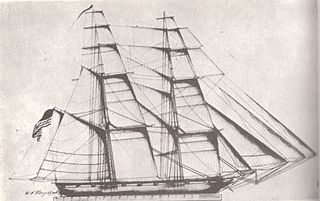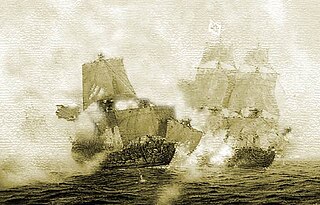
William Bainbridge was a commodore in the United States Navy. During his long career in the young American Navy he served under six presidents beginning with John Adams and is notable for his many victories at sea. He commanded several famous naval ships, including USS Constitution, and saw service in the Barbary Wars and the War of 1812. Bainbridge was also in command of USS Philadelphia when she grounded off the shores of Tripoli, Libya in North Africa, resulting in his capture and imprisonment for many months. In the latter part of his career he became the U.S. Naval Commissioner.

The USS Enterprise was a schooner, built by Henry Spencer at Baltimore, Maryland, in 1799. Her first commander thought that she was too lightly built and that her quarters, in particular, should be bulletproofed. Enterprise was overhauled and rebuilt several times, effectively changing from a twelve-gun schooner to a fourteen-gun topsail schooner and eventually to a brig. Enterprise saw action in the Caribbean, the Mediterranean, and the Caribbean again, capturing numerous prizes. She wrecked in July 1823.

The Second Barbary War (1815) or the U.S.–Algerian War was fought between the United States and the North African Barbary Coast states of Tripoli, Tunis, and Algiers. The war ended when the United States Senate ratified Commodore Stephen Decatur's Algerian treaty on 5 December 1815. However, Dey Omar Agha of Algeria repudiated the US treaty, refused to accept the terms of peace that had been ratified by the Congress of Vienna, and threatened the lives of all Christian inhabitants of Algiers. William Shaler was the US commissioner in Algiers who had negotiated alongside Decatur, but he fled aboard British vessels during the 1816 bombardment of Algiers. He negotiated a new treaty in 1816 which was not ratified by the Senate until 11 February 1822, because of an oversight.

USS President was a wooden-hulled, three-masted heavy frigate of the United States Navy, nominally rated at 44 guns; she was launched in April 1800 from a shipyard in New York City. President was one of the original six frigates whose construction the Naval Act of 1794 had authorized, and she was the last to be completed. The name "President" was among ten names submitted to President George Washington by Secretary of War Timothy Pickering in March of 1795 for the frigates that were to be constructed. Joshua Humphreys designed these frigates to be the young Navy's capital ships, and so President and her sisters were larger and more heavily armed and built than standard frigates of the period. Forman Cheeseman, and later Christian Bergh were in charge of her construction. Her first duties with the newly formed United States Navy were to provide protection for American merchant shipping during the Quasi War with France and to engage in a punitive expedition against the Barbary pirates in the First Barbary War.

USS Syren was a brig of the United States Navy built at Philadelphia in 1803. She served during the First Barbary War and the War of 1812 until the Royal Navy captured her in 1814. The British never commissioned her but apparently used her for a year or so as a lazaretto, or a prison vessel. She then disappears from records.

Rear Admiral Silas Horton Stringham was an officer of the United States Navy who saw active service during the War of 1812, the Second Barbary War, and the Mexican–American War, and who commanded the Atlantic Blockading Squadron at the beginning of the American Civil War.

The first John Adams was originally built in 1799 as a frigate for the United States Navy, converted to a corvette in 1809, and later converted back to a frigate in 1830. Named for American Founding Father and president John Adams, she fought in the Quasi-War, the First and Second Barbary Wars, the War of 1812, the Mexican–American War and the American Civil War.

USS Guerriere was the first frigate built in the United States since 1801. The name came from a fast 38-gun British frigate captured and destroyed in a half-hour battle by USS Constitution on 19 August 1812. This victory was one of the United States' first in the War of 1812.

Commodore John Downes was an officer in the United States Navy, whose service covered the first half of the 19th century.

The Mediterranean Squadron, also known as the Mediterranean Station, was part of the United States Navy in the 19th century that operated in the Mediterranean Sea. It was formed in response to the First and Second Barbary Wars. Between 1801 and 1818, the squadron was composed of a series of rotating squadrons. Later, squadrons were sent in the 1820s to the 1860s to suppress piracy, primarily in Greece and to engage in gunboat diplomacy. In 1865 the force was renamed the European Squadron.

The Mashouda or Meshuda was the Algerian fleet flagship of admiral Raïs Hamidou during the Second Barbary War. Stephen Decatur captured her in June 1815 at the Battle off Cape Gata. This created a favorable American position from which to bargain with the Dey of Algiers. Lloyd's List reported that the Algerine frigate Mezoura, which had been under the command of the Algerine admiral, had arrived at Carthagena on 20 June 1815 as a prize to Decatur's squadron. The newspaper also reported that Decatur's squadron had run another Spanish frigate onshore near Carthagena.

The Battle off Cape Gata, which took place June 17, 1815, off the south-east coast of Spain, was the first battle of the Second Barbary War. A squadron of vessels, under the command of Stephen Decatur, Jr., met and engaged the flagship of the Algerine Navy, the frigate Meshuda under Admiral Hamidou. After a sharp action, Decatur's squadron was able to capture the Algerine frigate and win a decisive victory over the Algerines.
USS Spitfire was the former Baltimore privateer Grampus that the United States Navy purchased. She was a heavily armed schooner built for service in the War of 1812, but did not see service until the Barbary Wars when she was sent with the American fleet to the Mediterranean to force an end to piracy of American ships.
USS Torch was a schooner—heavily armed with guns and carronades—in the United States Navy during the early years of the republic. She was built for service in the War of 1812, but did not see service until the Barbary Wars when she was sent with the American fleet to the Mediterranean to force an end to piracy of American ships.

USS Spark was a heavily armed brig in the services of the United States Navy, built for service in the War of 1812. However, she was completed too late for that war and was assigned, instead, to the Barbary Wars in the Mediterranean. After two voyages in support of that action, she was assigned to suppress pirates in the Caribbean, where she was successful in capturing a number of pirate ships and their crews.

HMS Epervier was an 18-gun Cruizer-class brig-sloop of the Royal Navy, built by Ross at Rochester, England, and launched on 2 December 1812. USS Peacock captured her in 1814 and took her into service. USS Epervier disappeared in 1815 while carrying dispatches reporting the signing of a treaty with the Dey of Algiers.

The action of 28 November 1751 was a naval engagement off Cape St. Vincent between a squadron of two Spanish ships of the line under captain Pedro Fitz-James Stuart and an Algerine squadron of two ships of the line under corsair Mohammed Chirif, which was fought from November 28 to December 2, 1751, and resulted in a victory for the Spanish fleet. The Algerine ships had come from the port of Algiers, and were acting as corsairs, conducting commerce raiding against Christian merchant ships and enslaving their crews. This was part of the Barbary slave trade, where the Barbary states, autonomous vassals of the Ottoman Empire, raided Christian settlements and merchant vessels for slaves to sell in their own cities. The corsairs targeted Spain, a Christian country, and the Spanish Navy was sent to track down the formidable Algerine force of two ships of the line, which posed a significant threat to any Christian vessels in the region. When the fleets sighted each other on November 28, 1751, they found that they were evenly matched with their opposition; both fielded two ships of the line.

Stephen Decatur Jr. was a U.S. naval officer and commodore. He was born on the eastern shore of Maryland in Worcester County. His father, Stephen Decatur Sr., was a commodore in the United States Navy who served during the American Revolution; he brought the younger Stephen into the world of ships and sailing early on. Shortly after attending college, Decatur followed in his father's footsteps and joined the U.S. Navy at the age of nineteen as a midshipman.
The Battle of Cape Palos was a naval engagement that took place between 9 and 10 June 1758, during the Spanish-Barbary Wars. A Spanish squadron of three warships intercepted an Algerian squadron of two warships escorting a prize ship. After a prolonged fight, the Algiers flagship surrendered. His consort eluded the battle, but wrecked and the prize ship escaped. Algiers flagship sank from the damage, but there were several prisoners and Christian slaves released.














